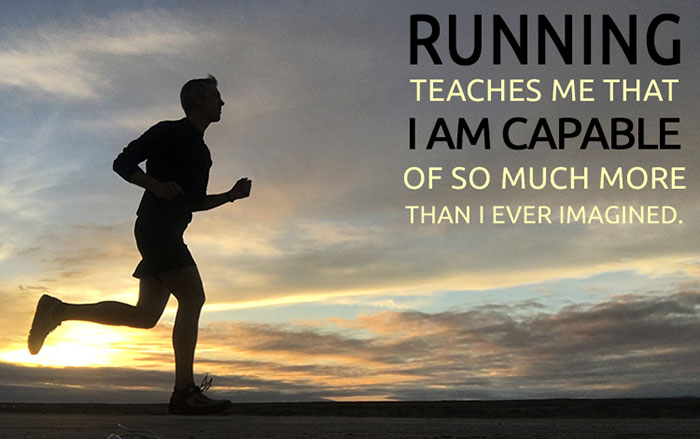
As a longtime runner and coach, I’ve become increasingly interested in the science that explains how we can tap into our psyche to run faster, stronger, or with a more “present” state of mind. For example, the overwhelming evidence of the power of the mind to improve our performance shows that we can increase speed and/or endurance with the belief we can (though of course, it’s not that simple). Henry Ford said it best: “Whether you think you can or you think you can’t, you’re right.”
Alongside the power of our mind to push our limits is the power to be more aware of who, where and how we are while running, a sort of centering. From that centering comes motivation, inspiration, joy and presence of mind, or “mindful” running.
Centering ourselves and being mindful reduces stress about what is coming up, whether it be a workout, race or long run. Projecting negative thoughts toward what is upcoming gives it a villainous personality, whereas viewing it as tough love for our body makes it feel more like a benefactor than a foe.
Being present and mindful is a habit we can teach ourselves. It takes focus and some guidelines, as the term can mean different things to different runners. To some, being truly mindful while running means leaving your watch and music at home and listening to your own thoughts. To others, it means being aware of your body: how it feels at any given moment, how you feel about your effort, your breathing, and your lightness of step. Yet others see mindful running as being connected to where they are: the physical location and sights they are moving through.
If you are in mid-training cycle and feel some loss of excitement, or if each training day is blending into the next, mindful running can give you a spark and a fresh way of seeing the upcoming run.
Try the following changes in your own training to help bring back the joy and freedom you felt before you stopped “simply running”:
Warm Up and Cool Down
Combine your effort to slow down during your warm-ups with mindfulness by really concentrating on the benefit of easing your body into the work part of the run. Allow yourself to go slower than you think you should, and know that by slowing down, you will not have to hold back later. During this time of focusing on an easy pace, we don’t have room in our minds to demonize the upcoming hard part.
Similarly, our cool-down can be our reward for a job well done, and we can give ourselves “permission” to slow down and let our bodies recover from the work, all the while monitoring each part of our body from the toes up. Is there a strong buzz in your quads and a relaxing ease in your glutes? Those might have always been there but by checking in with your body, you can enjoy all the good feels!
The Work
If we tell ourselves intervals are going to be hard and painful, they will be hard and painful. But by thinking only of the task at hand, we can then begin the “work” part of the run knowing we are charged up and prepared. Pushing hard when we need to isn’t formidable because we took care not to work too hard in our warm up. When the tempo run or intervals begin, we know we are ready without being already fatigued. Our heart and lungs are easing into it, and our legs are still eager.
Self-discipline, another form of mindfulness, is useful not only in pushing hard but also in making sure we don’t push too hard. If your plan says to run 400 meters 8 times with one minute of rest between, then only resting for 30 seconds may actually be counterproductive to your goals and potentially lead to injury. Have the self-discipline to stick to the plan.
Awareness of Effort
Could this run yield a breakthrough in feeling good about your even pace? Might this be the run that you begin to understand the breathing technique your coach has advised? Is the effort you’re expending really a 7-8 on a scale of 10? By bringing your thoughts back to yourself and away from the external (GPS, distance, etc.), you can internalize and begin to feel a comfortable or comfortably hard pace. It becomes easier to count strides or breaths and to recognize inefficient movements you can control, such as too much arm swing.
Mantras
A mantra is a line you repeat to get yourself back to your center place, the mentally alert state. Do you use a mantra? Does it work? When do you use it: every run? When things get tough? Before things get tough? Try one out as a starting point if you want to pursue the concept of mindful running.
Self-coaching mantras:
“I can do this.”
“I am strong and able.”
“Trust the training.”
“I believe in me. I believe in my goal.”
Or lyrical mantras:
“Beauty is all around me and I am part of it.”
“I am grateful for this path.”
“My heart is full, my path clear.”
Injury Prevention
Are you ignoring early signs of injury? Could turning off the music and practicing body awareness allow you to determine whether this is a temporary twinge or in fact you feel it every run and it is not getting better? Overcompensating with one part of your body to alleviate pain in another can lead to multiple injuries, and a quiet mind may help to recognize this by listening to what your body is telling you.
Visualization
Another small step in being present is putting yourself in the picture during a long run or a recovery run. Practice visualizing pulling that tree toward you rather than simply trying to reach it. Overcome the distance by admiring the changing leaves and art within the limbs. Is the sun setting as you run? Is the moon rising? Can you imagine getting closer to them? Imagine yourself turning the corner on Boylston Street in the home stretch of the Boston Marathon or seeing your upcoming race’s finish line with your goal time on the clock. Take pleasure in the virtual cinema all around you.
Several books and websites are available to discover the art and science of mindful running; how you define it will ultimately be personal to you, but reading different resources on the subject will be enlightening and clarifying. Here are some examples:
- Mindful Running, by Mackenzie Havey
- Let Your Mind Run, by Deena Kastor
- “Everything You Need to Know About Mindful Running,” Men’s Journal
- “How to Be Mindful When Running,” The New York Times
- Mindfulrunning.org
Whatever mindful running means to you, remember: you run for you. A strong you means you are a strong friend, spouse, parent or partner to those you care about. Practice mindfulness before you walk out the door, and you’ll experience the world in a whole new way.
Want to receive Bette’s monthly column in your Inbox? Be sure to subscribe to our newsletter or sign up as a RaceRaves member (it’s free)! And read her previous columns from Sept, Oct and Nov.
About our columnist:
 Bette Hagerty decided to run a 5K in 1992 after a few months of running around her neighborhood, using her car’s odometer to measure distances. When she found herself among a few hundred people talking about running, she knew she had found her community. Since then she has run several hundred races, from 5K to marathon distance and helped form two running groups.
Bette Hagerty decided to run a 5K in 1992 after a few months of running around her neighborhood, using her car’s odometer to measure distances. When she found herself among a few hundred people talking about running, she knew she had found her community. Since then she has run several hundred races, from 5K to marathon distance and helped form two running groups.
Bette is an RRCA Certified Running Coach and posts weekly Tuesday workouts on instagram as @BetteRunning. Her passions for running and writing have finally run into each other, and she looks forward to sharing her experiences and knowledge. She welcomes your glowing compliments at [email protected].
Other RaceRaves articles you’ll enjoy (trust us!):
Best Marathons in the U.S.
Races inspired by Hollywood
The three Rs of post-workout recovery
Best Bets for Boston Marathon Qualifying Races
Best Half Marathon Series in the US
Introducing your (smart) 50 States Map
Unconventional Races that dare to be different
And for more helpful articles, check out our blog!
Find this article informative? Please share it, and let others know RaceRaves is the premier online resource to DISCOVER, REVIEW & TRACK all their races and to CONNECT with other runners!
Great advice, mindfully composed, that is applicable beyond running. Thanks, Coach Bette.
Great article. Thanks for sharing!
Wonderful article and good reminder not only to practice mindful running but that “being mindful” is unique to each person/runner. Thanks!
Hi, Kevin- Thank you for the feedback. I didn’t realize there were comments on this article until recently. I’m glad you found it useful!